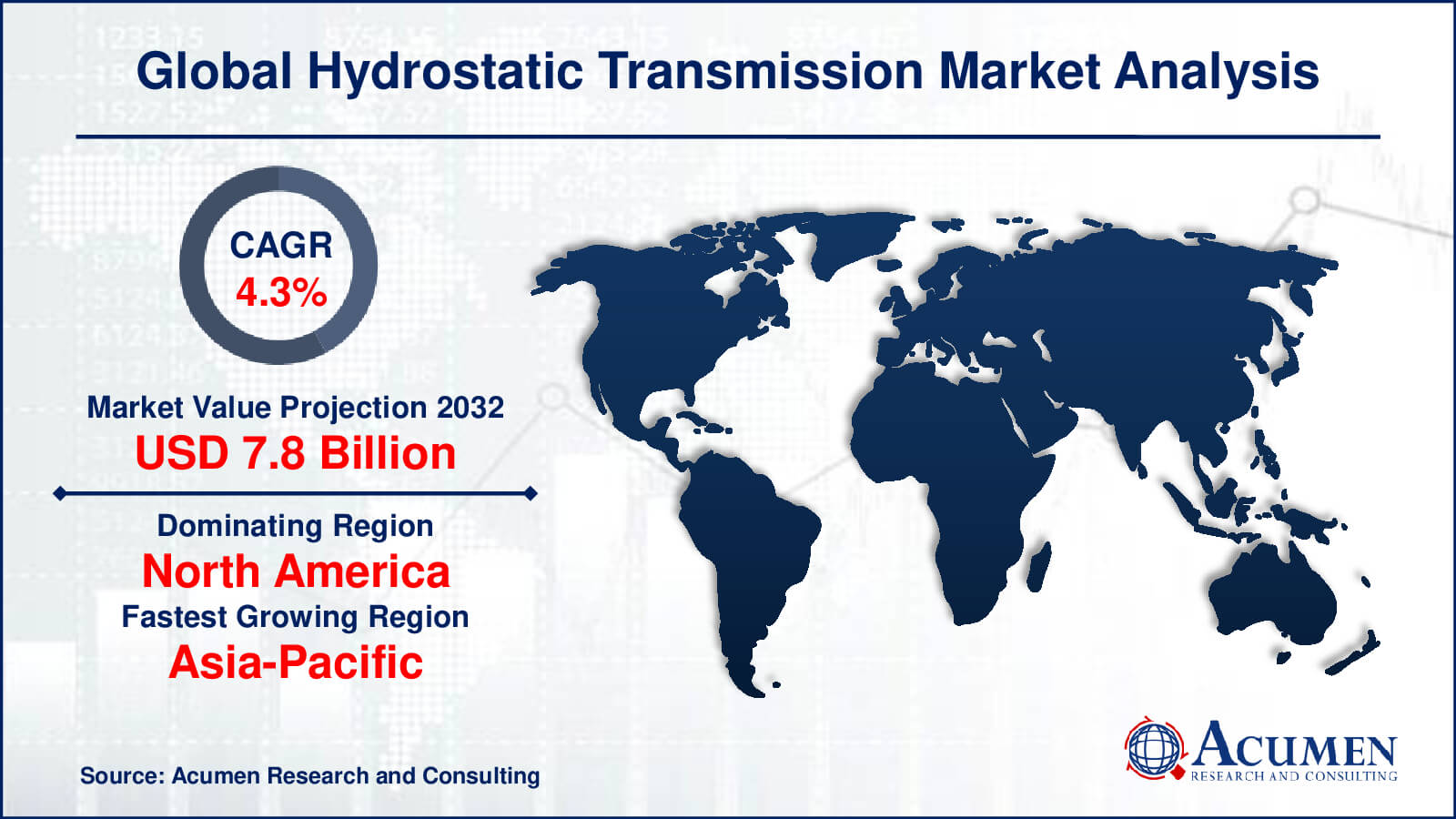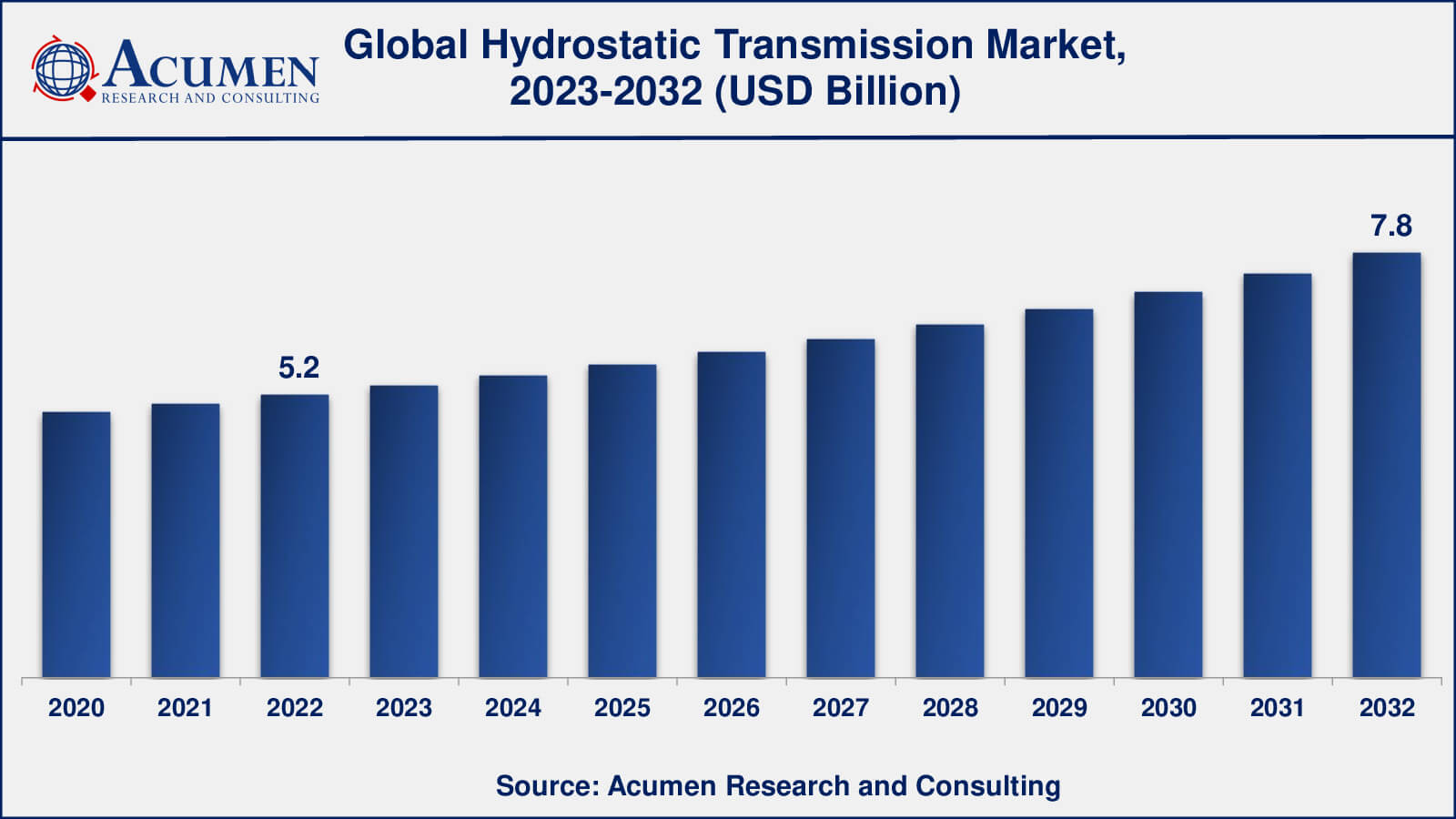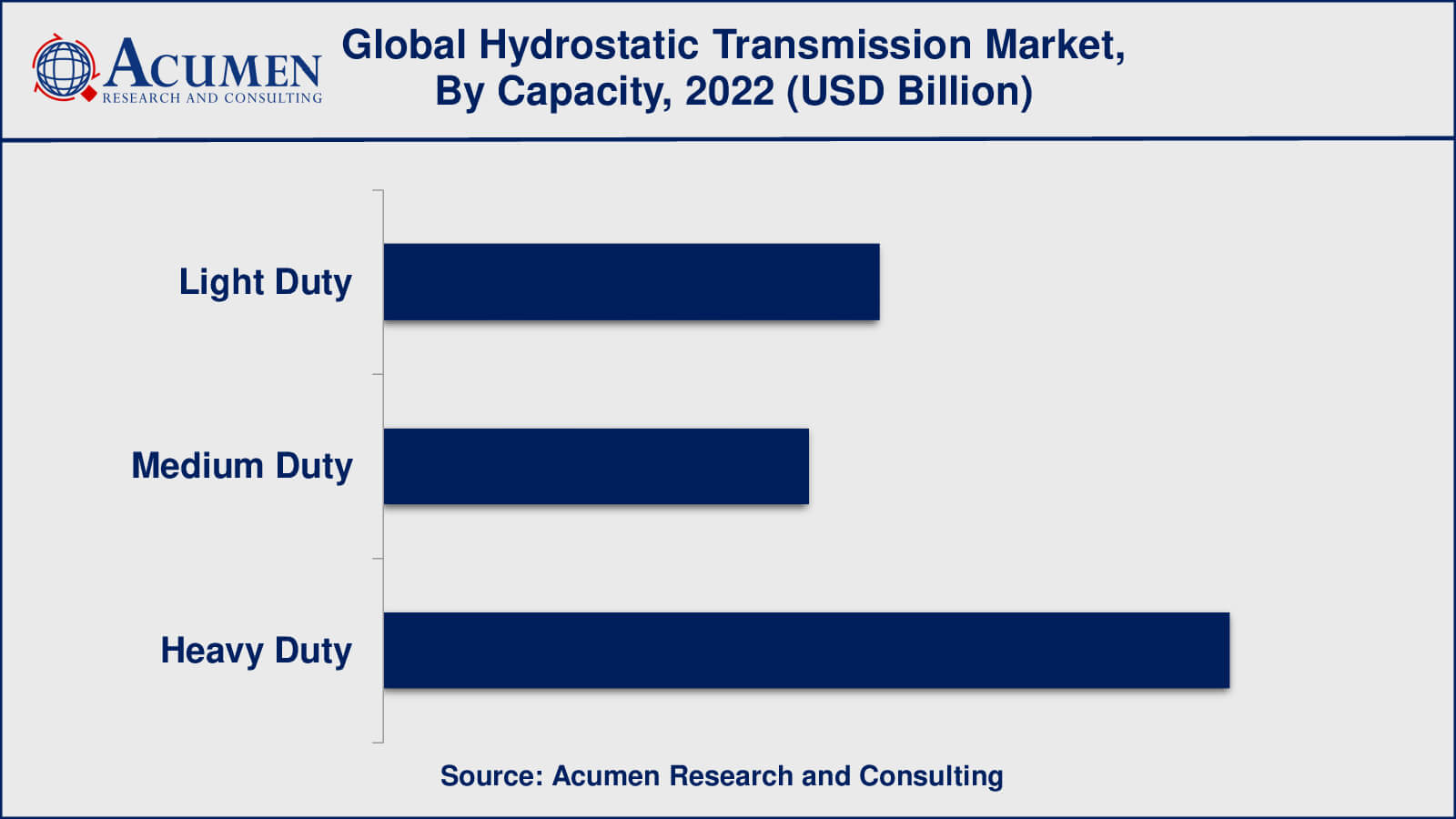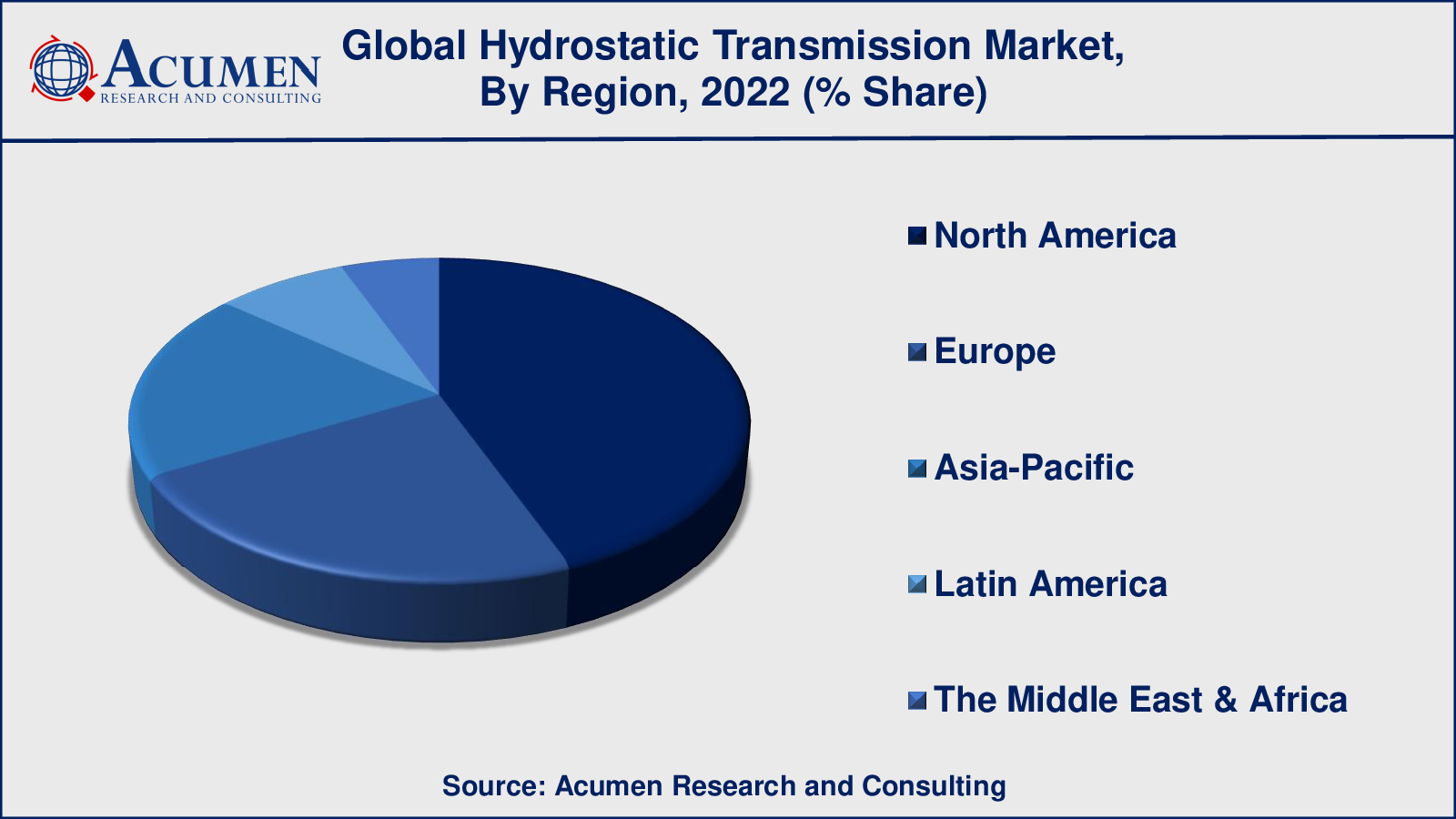April 2023
Hydrostatic Transmission Market size was valued at USD 5.2 Billion in 2022 and is projected to attain USD 7.8 Billion by 2032 mounting at a CAGR of 4.3% from 2023 to 2032.
The global Hydrostatic Transmission Market size was valued at USD 5.2 Billion in 2022 and is projected to attain USD 7.8 Billion by 2032 mounting at a CAGR of 4.3% from 2023 to 2032.
Hydrostatic Transmission Market Highlights

Hydrostatic transmission is a sort of power transmission system that transfers power from an engine or motor to the driven equipment using a hydraulic mechanism. It is based on fluid mechanics concepts and employs hydraulic fluid as a medium to convey power and regulate motion. Hydrostatic transmissions, as opposed to mechanical transmissions, use pumps, motors, and fluid-filled channels to convey power. A pump, powered by an engine or motor, provides a flow of hydraulic fluid in a hydrostatic transmission system. This fluid is then sent to a hydraulic motor, which transforms hydraulic energy back into mechanical energy to power the machinery. Valve controls the flow of fluid, which may be modified to produce variable amounts of torque and speed, allowing for smooth and accurate management of the equipment.
The ability of hydrostatic transmission to give variable speed control and high torque output is one of its primary features. The speed of the driven equipment may be readily modified by modifying the flow rate of the hydraulic fluid, providing flexibility in diverse working situations. As a result, hydrostatic transmissions are well-suited for applications requiring accurate speed and direction control, such as construction machinery, agricultural equipment, and industrial vehicles. The efficiency and durability of hydrostatic transmissions are well recognized. Hydraulic fluid reduces the mechanical losses associated with gear-based transmissions, resulting in increased energy efficiency. Furthermore, the lack of gears and shafts saves wear and tear, resulting in decreased maintenance requirements and a longer system lifespan.

Global Hydrostatic Transmission Market Dynamics
Market Drivers
Market Restraints
Market Opportunities
Hydrostatic Transmission Market Report Coverage
| Market | Hydrostatic Transmission Market |
| Hydrostatic Transmission Market Size 2022 | USD 5.2 Billion |
| Hydrostatic Transmission Market Forecast 2032 | USD 7.8 Billion |
| Hydrostatic Transmission Market CAGR During 2023 - 2032 | 4.3% |
| Hydrostatic Transmission Market Analysis Period | 2020 - 2032 |
| Hydrostatic Transmission Market Base Year | 2022 |
| Hydrostatic Transmission Market Forecast Data | 2023 - 2032 |
| Segments Covered | By Capacity, By End-User, And By Geography |
| Regional Scope | North America, Europe, Asia Pacific, Latin America, and Middle East & Africa |
| Key Companies Profiled | BP, Chevron Corporation, Exxon Mobil, Idemitsu Kosan, Indian Oil Corporation, LUKOIL, PetroChina, Royal Dutch Shell, Sinopec, and Total. |
| Report Coverage |
Market Trends, Drivers, Restraints, Competitive Analysis, Player Profiling, Covid-19 Analysis, Regulation Analysis |
Hydrostatic Transmission Market Insights
The rising demand for construction equipment and machinery is one of the key causes. Construction activity in the residential, commercial, and infrastructural sectors is increasing, necessitating the use of powerful and adaptable equipment. Hydrostatic transmissions provide precise control, tremendous torque, and variable speed capabilities, making them suitable for excavators, bulldozers, and loaders.
There is a rising emphasis in the agriculture industry on modern machinery to boost production and efficiency. Hydrostatic transmissions offer the necessary power and control for a variety of agricultural equipment, such as tractors, combines, and sprayers. As the need for mechanized farming practices grows so will the use of hydrostatic transmissions in agricultural gear.
Industrial End-Users also help to drive the hydrostatic transmission industry forward. Material handling, mining, and manufacturing all demand equipment that can bear big loads while still providing precise control. Hydrostatic transmissions provide the required power and flexibility to satisfy these demands, resulting in its widespread use in industrial machines and automobiles.
However, there are several constraints that influence market dynamics. The high initial price of hydrostatic transmission systems can be an impediment to their broad adoption. These systems have intricate hydraulic components that can be costly to build and install. Furthermore, the expenditures of hydraulic system maintenance and repair can contribute to the overall cost of ownership.
Technological innovations that continue to increase the efficiency and performance of hydrostatic transmissions provide opportunities. Hydraulic component, control system, and material innovations are improving the overall efficiency and longevity of these systems. Furthermore, untapped opportunity exists in emerging markets in developing nations for the hydrostatic transmission industry. These regions' increasing industrialization and infrastructural development provide chances for the use of hydrostatic transmission technology.
Another possibility is the use of hydrostatic transmissions in electric and hybrid cars. Hybrid and electric cars are gaining popularity as the automobile industry focuses on lowering emissions and boosting fuel economy. Hydrostatic transmissions can be used with electric powertrain to improve performance and efficiency, hence contributing to market development.
Hydrostatic Transmission Market Segmentation
The worldwide market for hydrostatic transmission is split based on capacity, end-user, and geography.
Hydrostatic Transmission Capacities

According to the hydrostatic transmission industry analysis, the heavy-duty segment has historically dominated the hydrostatic transmissions market. Heavy-duty applications, such as construction and mining machines, require transmission systems that can handle high torque and large weights. Hydrostatic transmission provides the required torque and control for heavy-duty applications. However, market dynamics can vary over time, and the dominance of a given capacity category may have evolved since then. Recent market research papers or industry analyses pertaining to the hydrostatic transmissions market are advised for the most up-to-date information.
Hydrostatic Transmission End-Users
According to the hydrostatic transmission market forecast, the agriculture industry has long been a leading end-user of hydrostatic transmissions, Agriculture largely relies on gear and equipment such as tractors, combines, sprayers, and harvesters, which frequently use hydrostatic transmissions to give precise control and high torque capabilities.
It is crucial to note, however, that the hydrostatic transmissions market is driven by a variety of variables, and the dominance of a given end-user sector may change over time. Other industries, such as construction and mining, logistics and transportation, and others, add to the demand for hydrostatic transmissions.
It is advisable to refer to latest market research papers or industry analyses relevant to the hydrostatic transmissions industry for the most up-to-date information on the prominent end-users in the hydrostatic transmissions market.
Hydrostatic Transmission Market Regional Outlook
North America
Europe
Asia-Pacific
Latin America
The Middle East & Africa

Hydrostatic Transmission Market Regional Analysis
The hydrostatic transmission sector has a strong presence in the North American market. The United States and Canada are significant contributors to market growth, owing to infrastructure expansion, building activity, and the agricultural sector. Technological improvements and the deployment of modern machinery drive the market in this area even further.
European nations with a major presence in the hydrostatic transmission market include Germany, France, the United Kingdom, Italy, and Spain. The increase of building and mining operations, notably in Eastern European nations, is driving market growth in Europe. Adoption of hydrostatic transmissions is further aided by stringent rules encouraging energy efficiency and environmental practices.
The hydrostatic transmission market in the Asia-Pacific region is expanding rapidly. China, Japan, India, South Korea, and Australia are key market contributors. The need for hydrostatic transmissions in this region is driven by rapid industrialization, infrastructural expansion, and expanding agricultural mechanization. Growing building projects, urbanization, and investment in cutting-edge gear all contribute to market expansion.
Hydrostatic Transmission Market Players
Some of the top hydrostatic transmission companies offered in our report include BP, Chevron Corporation, Exxon Mobil, Idemitsu Kosan, Indian Oil Corporation, LUKOIL, PetroChina, Royal Dutch Shell, Sinopec, and Total.
Hydrostatic Transmission Industry Recent Developments
Looking for discounts, bulk pricing, or custom solutions? Contact us today at sales@acumenresearchandconsulting.com
April 2023
March 2025
September 2020
April 2023